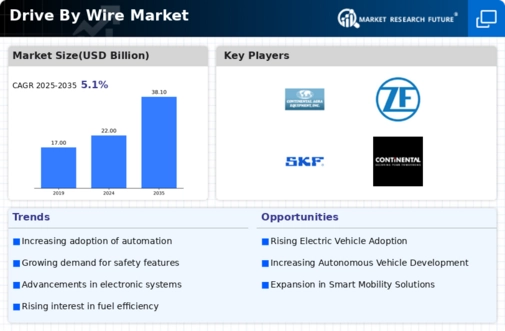Top Industry Leaders in the Drive-by-wire Market
*Disclaimer: List of key companies in no particular order
Navigating the Dynamic Terrain: Unraveling the Intricacies of the Drive-by-Wire Sector
The drive-by-wire (DBW) realm is gearing up for an exhilarating journey filled with intricacies and surprises. By substituting traditional mechanical controls with electronic interfaces, DBW systems not only offer heightened precision, safety, and autonomy but also magnetize both industry titans and agile startups. As the dust settles from the initial burst of acceleration, a vivid panorama of the competitive landscape emerges, characterized by strategic acumen, a mosaic of players, and ever-shifting trends.
Strategic Moves and Players' Approaches:
Dominance of Tier 1 Automotive Suppliers:
Established players like Bosch, Continental, Denso, and ZF Friedrichshafen AG command a significant position, leveraging enduring partnerships with automakers and extensive expertise in integrating DBW components. Their strategies orbit around perpetual innovation, strategic alliances, and expansion into novel application sectors such as heavy-duty vehicles and off-highway machinery. (Source: Fact.MR, October 2023)
Pioneers in Technology:
Enterprises like Google, Apple, and Baidu are progressively venturing into the DBW arena, capitalizing on their proficiency in software and sensor technologies. Their focal point lies in autonomous driving solutions, wherein DBW plays a pivotal role. Noteworthy is Google's Waymo self-driving cars, employing sophisticated DBW systems. (Source: Fortune Business Insights, November 2023)
Emerging Trailblazers:
Compact and agile entities like Adient and Visteon are etching a distinctive niche by specializing in specific DBW sub-systems or catering to smaller vehicular segments. These startups frequently collaborate with established counterparts or concentrate on unique features like haptic feedback for steering controls. (Source: MarketsandMarkets, October 2023)
Determinants for Market Share Assessment:
Technological Prowess: Companies with avant-garde strides in sensor technology, software algorithms, and cybersecurity protocols are poised to seize a competitive edge. Recent innovations such as redundant systems and fail-safe mechanisms stand pivotal for dominating market shares.
Geographical Influence: The Asia-Pacific region, particularly China, is anticipated to emerge as the fastest-growing market owing to escalating vehicle production and governmental initiatives promoting electric vehicles. Established entities with robust regional presence are poised for advantageous positions.
Vertical Expertise: Tailoring DBW solutions to specific vehicle segments, be it luxury cars, commercial vehicles, or electric vehicles, can confer a competitive advantage.
Industry Dynamics and Recent Unveilings:
-
September 2023: Continental unveils a collaboration with Baidu, aiming to develop AI-powered DBW systems for autonomous vehicles in China. (Source: Reuters, September 2023)
-
October 2023: ZF Friedrichshafen AG introduces a novel lightweight brake-by-wire system, targeting the reduction of vehicle weight and enhancement of fuel efficiency. (Source: Automotive News, October 2023)
-
November 2023: Tesla rolls out an update for its Autopilot software, featuring enhanced steering control through its DBW system, sparking speculation about broader deployment in upcoming models. (Source: Electrek, November 2023)
Novel and Emerging Trends:
Cybersecurity Apprehensions: With the escalating complexity of DBW systems, data security and preemptive measures against hacking are emerging as paramount concerns. Companies are making substantial investments in cybersecurity measures to instill confidence and avert potential safety breaches.
Integration with Advanced Driver-Assistance Systems (ADAS): The demarcation between DBW and ADAS is fading, given features like adaptive cruise control and lane departure warning that hinge on precise control of vehicle inputs. Seamless integration is imperative for a seamless driving experience.
Personalization and Customization: User predilections for steering feel, throttle response, and braking behavior are anticipated to propel the demand for customizable DBW settings, ushering in a new era of personalized driving experiences.
Holistic Competitive Scenario:
The DBW landscape is witnessing a dynamic interplay among entrenched players, technological forerunners, and inventive startups. While Tier 1 suppliers currently hold sway, the future belongs to those capable of swift innovation, adept adaptation to evolving regulations and consumer preferences, and proactive tackling of cybersecurity concerns. Collaboration and strategic alliances emerge as indispensable for navigating this intricate terrain and unlocking the complete potential of DBW technology.
As the technology matures and gains wider prevalence, its imprint on the automotive industry is poised to be profound, paving the way for safer, more efficient, and ultimately, more autonomous vehicles.

